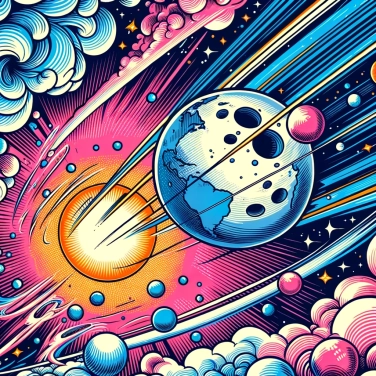The Moon does not fall on Earth because of the balance between the gravitational force that pulls the Moon towards Earth and the speed at which the Moon moves, allowing it to remain in orbit around Earth.

Earth's gravity acts on the Moon much like an invisible string that keeps an object revolving around itself when you spin it with your arm. This attractive force constantly holds the Moon in place, preventing it from drifting off into space, but without pulling it down to the Earth's surface. In practical terms, the Earth pulls the Moon towards it, continually guiding its movement by slightly curving its trajectory. This mutual attraction is also responsible for the tides on our planet: the Moon constantly pulls on the oceans, causing the water levels to fluctuate as it moves through space around us. Without this ongoing gravitational interaction, the Moon would fly straight off and quickly disappear from our celestial environment.
The speed of the Moon plays a key role in preventing it from falling onto the Earth. The Moon moves quickly sideways (orbital speed), which perfectly counterbalances the pull of Earth's gravity. Basically, it is constantly falling towards the Earth, but since it is moving super fast horizontally, it misses it every time. This phenomenon is called orbital free fall. If the orbital speed were to decrease slightly, our satellite would end up getting dangerously close to the Earth, while an increased speed would send the Moon off into space. The current speed corresponds to a precise balance, allowing this spatial dance to continue smoothly for billions of years.
When an object orbits a planet like the Moon around the Earth, two major players come into play: gravity, which pulls the Moon toward the Earth, and its inertia, the natural tendency of moving objects to continue in a straight line. If gravity suddenly disappeared, the Moon would fly straight into space, directly ahead of it! Conversely, without this inertia and at its current speed, it would fall directly onto us. Its orbit is a rather brilliant balance: a kind of perpetual fall where it continually falls toward the Earth while systematically missing it due to its sufficient speed, which ensures a curved and stable trajectory. In short, a delicate balance that constantly maintains the ideal distance between it and us.
Newton demonstrated that two bodies attract each other with a force called universal gravitation. The more massive the objects are, the stronger this attractive force is, but the farther apart they are, the weaker it acts. The Moon orbits the Earth because Earth's gravity acts like an invisible string: it pulls it in, but as the Moon constantly moves at its own speed, it always misses the Earth and continues its orbital path. This dance, governed by Newton's laws of motion, continuously balances attraction and inertia, thus preventing the Moon from falling onto our planet or drifting away from it.
The Sun also exerts its attraction on the Earth and the Moon, which slightly alters their motion. Even though the Earth strongly attracts the Moon, solar gravity disrupts this distant dance by creating small variations called orbital perturbations. This has a concrete role: for example, during the periods of full or new Moon, the Earth-Moon-Sun alignment causes what are known as spring tides (very high tides) since at these times, the gravitational forces combine. These complex interactions also explain why the lunar orbit is not perfectly round, but slightly elongated. Without the subtle influence of the Sun, the Earth-Moon dynamics would be very different.
Without the Moon's gravity, the length of a day on Earth would be much shorter: about 6 to 8 hours instead of the current 24 hours. This is due to the stabilizing effect of the Moon on Earth's rotation.
Ocean tides are primarily caused by the gravitational attraction between the Earth and the Moon. Without our natural satellite, the variations in ocean levels would be much less significant.
The term 'blue moon' does not mean that the Moon changes color, but rather that it refers to the second full moon that occurs in the same calendar month. This rare phenomenon happens approximately once every two and a half years.
Although Earth's gravity keeps the Moon in orbit, did you know that the Moon also causes a slight deformation of our planet? This deformation of the ground is called the Earth tide and can reach up to 30 centimeters in some places.
If the orbital speed of the Moon were to decrease significantly, the Moon would gradually drift closer to the Earth along a spiral trajectory, potentially leading to a theoretical collision. However, in reality, other complex effects would also influence this process.
Absolutely. All natural satellites in the solar system obey the same physical laws, particularly Newton's laws of universal gravitation, which explains their respective orbital balance around different planets.
The Sun exerts a gravitational influence on the entire Earth-Moon system. This gravitational force contributes to slight variations in the lunar orbit, but it is not strong enough to significantly disrupt its stability around the Earth.
The direct influence of the Moon is very subtle on a small scale. However, on a planetary scale, its gravity causes the phenomenon of ocean tides. These tides mainly manifest as the regular variation in the levels of seas and oceans.
The Moon does not fall to Earth because it has sufficient orbital speed that precisely balances the gravitational force of the Earth, keeping it on a stable circular trajectory around our planet.

No one has answered this quiz yet, be the first!' :-)
Question 1/5